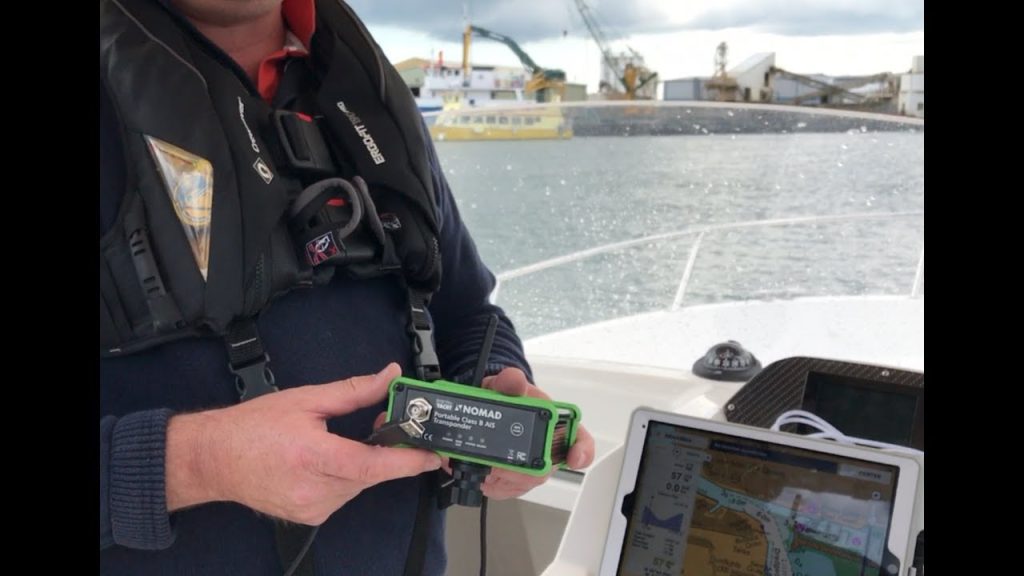The Exposure OLAS Float-On is one hell of a flashlight (or “torch” in Brit speak). That’s because it’s also an automatic water-activated MOB strobe light and a Bluetooth MOB alerting device that can network with smartphone apps and more familiarly styled MOB tags. Details follow, along with several other interesting new safety products that also got the attention of the DAME Award judges at METS…

First, let’s sort out the names. Exposure Lights is a UK firm developing technical “torches” for boating and other demanding niches; OLAS, as in Overboard Location Alert System, is the Bluetooth tag and app MOB system (above) that Exposure rolled out early this year; and the Float-On light is a brand new multifunction addition to the OLAS family.
You may notice that the original OLAS tags and apps seem very similar to the CrewWatcher system I beta tested in January. In fact, the OLAS Float-On and what is now coming to market as the Weems & Plath CrewWatcher were both DAME Award safety category nominees with CrewWatcher receiving the award.
I sympathize with the DAME judges’ comment that starts “After much debate…” because try as they might to be simple to use, these are actually complex communications systems, and the real devil is in details like how well they manage false alarms caused by Bluetooth obstructions. We’ll know more this coming year as lots of reasonably priced CrewWatcher, OLAS and also Sea-Tag smartphone/Bluetooth systems get out into the real boating world.

But assuming that one or more of these modern MOB alerting and location systems is truly practical, it seems smart that a compact flashlight/strobe could also serve as a Bluetooth tag. The Float-On may cost about $130 when it ships early in 2018, but, for starters, it’s a floating waterproof rechargeable flashlight with three levels of illumination that range from 10 lumens for 20 hours to 120 lumens for 1 hour.
Apparently, the two goldplated contacts inset into the base, which enable automatic strobe activation upon submersion, — the Float-On is designed to float LED light up — also support a snap-on USB charging cable. I suppose that there are scenarios where you might regret that you used the flashlight as much as you did one fateful night, but then again a strobe seems the perfect complement to a MOB system that quickly marks where you went overboard but can’t track you after that.

And, incidentally, there are two other new lifejacket strobe lights out this fall. The Weems & Plath Personal Rescue Strobe features a unique visibility-extending light cone — which I plan to test soon — while the North American Survival Systems EF-30A-1 adds three IR LEDs to the normal white lights so it’s visible to search and rescue personnel wearing night vision goggles.
Add all this to the evolving field of AIS MOB devices and don’t you wonder what future personal safety gear will look like?
Vesper deck Watch

The Vesper deckWatch is the latest element in the smartAIS feature family that rolled out in 2017. It’s an app that runs on Android Wear 2.0 smart watches and integrates via WiFi with Vesper XB8000 and Vision AIS transponders, delivering both the multiplexed boat data those devices have long supported plus new smartAIS features like smartly designed AIS collision, AIS MOB, and anchor drag alarming.
While Vesper only received a DAME nomination for deckWatch — besides the CrewWatcher win, the McMurdo AIS EPIRB received a well deserved Special Mention — the judges in Tampa gave it a 2017 IBEX Innovation Award. That was an interesting debate in which I got to participate.

What strikes me as deeply innovative about deckWatch as well as the smartAIS phone and tablet apps is that while they make terriffic use of mobile devices to interface with powerful safety capabilities, the safety is not then dependent on the mobile devices.
In the IBEX booth photo above, note the external alarm and switch that now ships with that blue XB8000 AIS transponder. I suspect that using your wrist watch to setup and monitor an anchor watch is great, and I know it’s great to setup and see Vesper’s still-unequaled AIS alarming modes on an iPad, but I think it sensational that the buzzer alarm will still fire off even if the mobile is shut down or busy with something else.

Staying with the smartAIS anchor watch feature, here’s what it often looked like on my iPad as I recently puttered down Chesapeake Bay. Note that you can easily adjust where you think the anchor is relative to your boat, nice because few of us remember to establish a watch when we drop it, and also because the tracking will eventually improve your understanding of where it actually took hold.
Also note that with NMEA 2000 input, seen on the right-hand screen, the screen shows Gizmo‘s true heading as well as water depth. I’d like Vesper to add wind speed and direction time graphs to the screen margins when the data is available, and also to change the boat icon to a circle when only COG is known, but that’s icing on the cake.
What’s really smart about “smartAIS” is that the real brains are in the transponder, not in the tablet or watch. So even if I hadn’t run the WatchMate app for hours, an up-to-date anchor watch track history would come up. And, most important if Gizmo dragged outside the watch circle I set, the buzzer went off even if I’d killed the iPad battery streaming videos before falling into a deep sleep.


